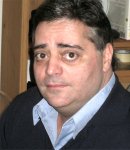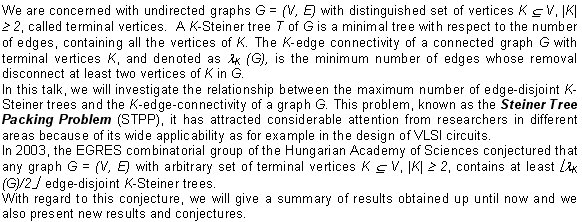|
|
Plenary Lecture
On the Problem of Packing Trees in Graphs

Professor Louis Petingi
Department of Computer Science
College of Staten Island
City University of New York
2800 Victory Boulevard
Staten Island, New York, 10314
USA
E-mail:
petingi@mail.csi.cuny.edu
Abstract:

Brief Biography of the Speaker:
Dr. Louis Petingi obtained his Ph.D. in Computer Science in 1991 from
Stevens Institute of Technology (New Jersey, USA) in the fields of
Extremal Graph Theory and Network Reliability. He is currently a
Professor of Computer Science at the College of Staten Island (City
University of New York). He has recently introduced a new network
reliability measure, the Diameter-Constrained Network Reliability (DCR)
that determines the probability that a communication network meet delay
constraints among a set of participating nodes, given that the set of
edges fail independently with known probabilities. Classical network
reliability models are based on the existence of end-to-end paths
between network nodes, not taking into account the length of these
paths. For many applications this is inadequate because the connection
will only be established or attain the required quality if the distance
between the participating nodes does not exceed a given value (e.g.,
broadcasting, wireless networks). The DCR of a communication network not
only considers the underlying topology, but it also imposes a bound on
the diameter, which is the maximum distance between the nodes of the
network.
With respect to optimization problems in Graph Theory, Dr. Petingi has
achieved international recognition for introducing new techniques to
characterize graphs with maximum number of spanning trees among
competing topologies with equal number of vertices and edges. This
problem has been tackled without much success by many well-known Graph
Theorists since the 1960ís because of its applicability in the design of
reliable networks.
Dr, Petingi is a permanent faculty member of City University of New York
Graduate Center and he has obtained several research grants. He is a
member of the ACM, and the New York Academy of Sciences.
|
|
|